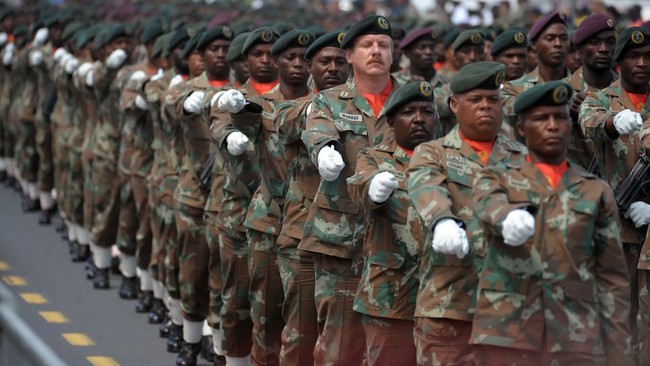Synopsis: From regional peacekeeper to defence technology innovator, South Africa stands at a crucial crossroads. With its advanced military industry led by Denel facing budget constraints, and increasing demands for African peacekeeping missions, the nation must navigate complex choices between social development and military investment. This analysis explores how South Africa balances its continental security responsibilities with domestic challenges in an evolving security landscape
South Africa’s Journey from Apartheid to African Peacekeeping
South Africa transitioned from apartheid minority rule to a democracy in the 1990s. Throughout its liberation history South Africa has had significant connections with other African countries. These included the frontline states like Mozambique, Zimbabwe, Tanzania, etc. Here the African National Congress’s (ANC) military wing Umkhonto we Sizwe used these frontline states for military support and guerilla capabilities to combat the apartheid government. South Africa’s assistance and African peacekeeping effort, and positions itself as a voice for democracy, fairness, and negotiation as a means for de-escalation.
Commitment to African Peacekeeping Missions
South Africa has committed itself to regional and continental stability. South Africa’s official government policy is considerably focused on peace and diplomacy. It aligns itself with the multidimensional peace support of the United Nations (UN), African Union (AU) and the Southern African Development Community (SADC). In 1998, South Africa’s peace mission in Lesotho to prevent the Royal Lesotho Defence Force from having a government coup. The Department of International Relations and Cooperation (DIRCO) of South Africa began to focus on instability in the Democratic Republic of Congo (DRC). South Africa has been deeply involved in the DRC and supports the electoral process in a bid to prevent conflict and insurrection as a result of a failed electoral process.
The Growth of South Africa’s Defence Manufacturing Industry
South Africa has developed a high level of self-sufficiency in arms production, manufacturing of weapons and ammunition, including army vehicles, communication and electronic warfare systems. These provided equipment and products for challenging regional terrain. In the mid 1980s, Armscor had about 2 270 private sector firms, 1,100 subcontractors. Major private sector suppliers at this time were Altsch (electronics), Reunert (electronics and main battle tanks), Grintek (electronic), and Dorbyl (armoured vehicles and shipyards). The private sector contributed to approximately half of the equipment needed for the South African Defence Force (SADF).
Today, still in existence, Rheinmetall Denel Munition (RDM), is South Africa’s weapon manufacturing company with Rheinmetall owning 51% of the company and Denel owning 49% of the company.
Weighing Military Spending Against Social Needs
The issue of budgeting military expenditure with social support programs, however, the South African government provides more social services than they do invest in the military. South Africa’s military expenditure for the year 2023/2024 was at $23.63 billion, according to South Africa’s official treasury report. This is approximately $2.97 billion (0.74%) of South Africa’s official GDP. It is also some of the smallest military budgets. Conversely, it is outcompeted by the country’s Social Development budget comprising around $21.48 billion (5.37%) of GDP.
Challenges and the Future of South Africa’s Defence Strategy
The social development needs are still rife in South Africa. As one of the most unequal countries in the world. Many South Africans still battle with poverty; almost half of the population are dependent on grants. Research indicates that South Africa spends less on its military than it does on social development.





